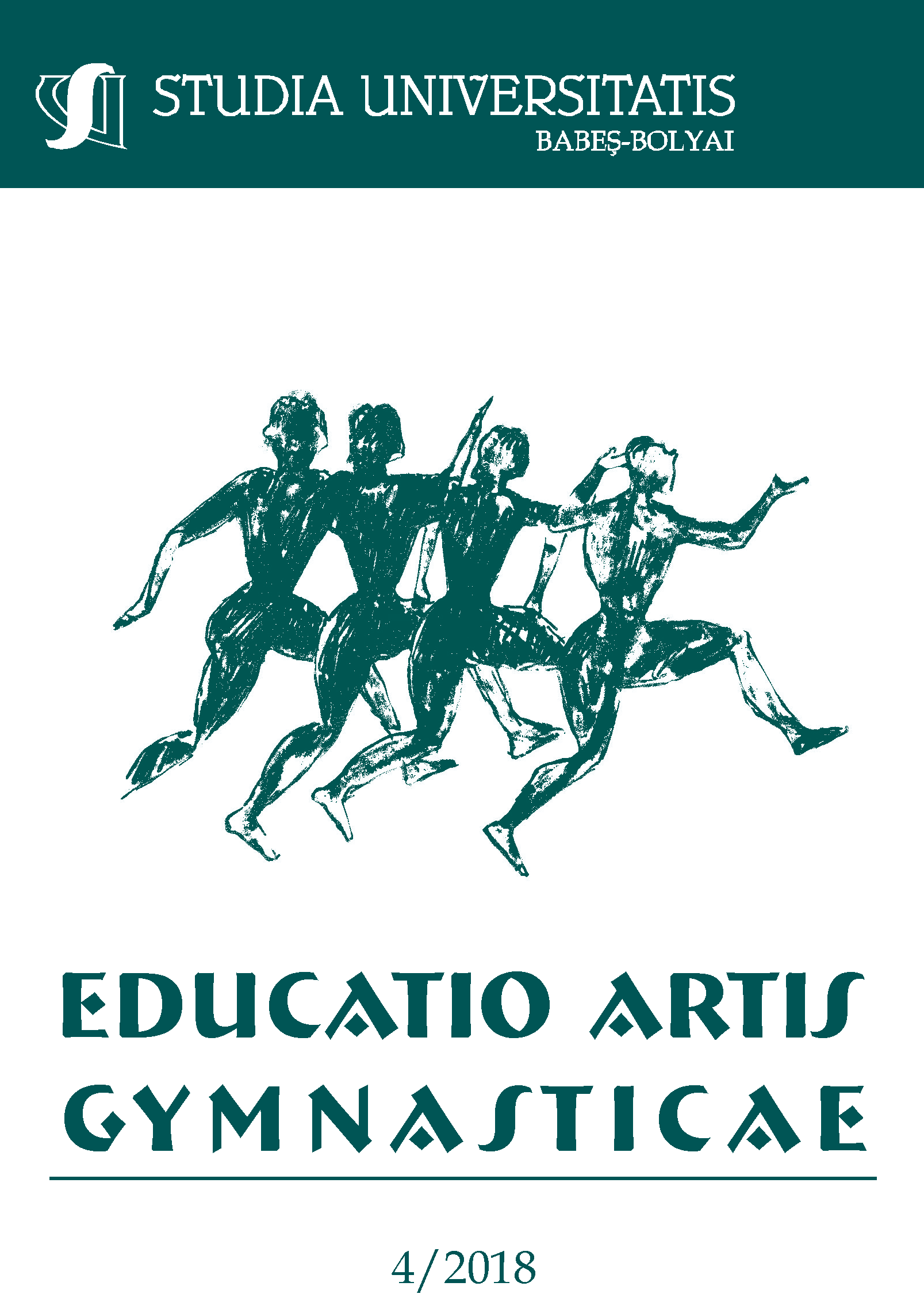OPTIMIZING THE COORDINATION SKILLS OF 12-YEAR-OLD TENNIS PLAYERS BY USING UNCONVENTIONAL (ADAPTED) TRAINING METHODS
DOI:
https://doi.org/10.24193/subbeag.63(4).35Keywords:
tennis, performance, coordination abilities, unconventional drills.Abstract
The modern tennis is characterized by the restructuring of training content in the context of great performance of nowadays sports. Latterly, tennis implies a specific background of players' skills, which includes, first of all, a multifaceted training, the manifestation of a great level of creation, tactical inventiveness that can only be expressed by individuals who have reached a high level of technical, physical and psychological abilities. The significance of physical training is unanimously acknowledged, as it is the support of the players' activity, which can use their technical-tactical and psychological possibilities during training sessions and competitions. Under these circumstances, the need to apply "unconventional" training methods and create appropriate drills to positively influence the performance capability is, from our point of view, an essential preoccupation of the motricity specialist. Current performance training cannot be anchored in definitive template shapes.
REZUMAT. Optimizarea capacităților coordinative în jocul de tenis utilizând metode neconvenționale la copiii de 12 ani. Tenisul modern se caracterizează prin restructurarea conținutului pregătirii, în contextul amplificării spectacolului sportiv. Azi, tenisul presupune un fond specific de aptitudini ale jucătorilor, care include în primul rând o pregătire polivalentă, manifestarea unei mari libertăți de creație, de inventivitate tactică, ce nu poate fi exprimată decât de indivizii care au atins un înalt nivel de măiestrie tehnică, fizică si psihologică. Însemnătatea pregătirii fizice este unanim recunoscută, deoarece constituie suportul activității jucătorilor care astfel își pot valorifica posibilitățile tehnico-tactice si psihologice. În aceste condiții, necesitatea aplicării unor mijloace și metode de pregătire inedite, “neconvenționale” adecvate influențării pozitive a capacității de performanță, reprezintă din punctul nostru de vedere o preocupare esențială a specialistului din domeniul motricității.
Cuvinte cheie: tenis de câmp, performanţă, capacitate coordinativă, mijloc nespecific.
References
Akutagawa, S., Jojima, T. (2005). Trunk rotation torques through the hip joints during the one‐ and two‐handed backhand tennis strokes. J Sports Sci, 23781–793.793.
Akutagawa, S., Kojima, T. (2005). Trunk rotation torques through the hip joints during the one- and two-handed backhand tennis strokes. Journal of Sports Sciences, 23(8), 781-793.
Alexe, N. (1993). Antrenamentul sportiv modern, Bucuresti, Ed. Edilis.
Carstea, G. (1993). Teoria şi metodica educaţiei fizice şi sportului, Bucuresti, Ed. Sport Turism.
Dragnea, A. (1984). Masurarea şi evaluarea în educatie fizica şi sport, Bucuresti, Ed. Sport Turism.
Dragnea, A. (1996). Antrenamentul sportiv, Bucuresti, Ed. Didactică şi Pedagogică.
Dragnea, A. Bota, A. (1999). Teoria activităţilor motrice, Bucuresti, Ed. Didactică şi Pedagogică.
Elliott, B. (2003). The development of racquet speed. Biomechanics of advanced tennis. Editors. Valencia, Spain: ITF Publications; 33-47.
Elliott, B., Reid, M., Crespo, M. (2009) Backhand mechanics. Technique development in tennis stroke production. ITF Publications, 109-123.
Elliott, B., Takahashi, K., Noffal, G. (1997). The influence of grip position on upper limb contributions to racket head velocity in a tennis forehand. J Appl Biomech, 13182–196.
Elliott, B.C., Marsh, A.P., Overheu, P.R. (1989). The topspin backhand drive: a biomechanical analysis. Journal of Human Movement Studies, 16, 1-16.
Eng, D., Hagler, D. (2014). A novel analysis of grip variations on the two-handed backhand. ITF Coaching and Sport Science Review, 62(22) 14-15.
Epuran, M., & Marolicaru, M. (2003). Metodologia cercetării activităţilor corporale, Cluj-Napoca, Ed. Risoprint.
Erman, K.A., Şahan, A., Küçükkaya, A. (2013). The effect of one and two-handed backhand strokes on hand-eye coordination in tennis. Procedia - Social and Behavioral Sciences 93, 1800-1804.
Kawasaki, S., Imai, S., Inaoka, H., Masuda, T., Ishida, A., Okawa, A., Shinomiya K. (2005). The lower lumbar spine moment and the axial rotational motion of a body during one-handed and double-handed backhand stroke in tennis. International Journal of Sports Medicine, 26(8), 617-621.
Kibler, W.B., McQueen C, Uhl T. (1988). Fitness evaluations and fitness findings in competitive junior tennis players. Clin Sports Med, 7403–416.416.
Kovacs, M., Chandler, W.B., and Chandler, T.J. (2007). Tennis Training: Enhancing On-Court Performance. Vista, CA: Racquet Tech Publishing pp. 23.
Kovacs, M.S, Roetert EP, and Ellenbecker, T.S. (2008). Efficient deceleration: The forgotten factor in tennis-specific training. Strength Cond J, 30(6): 58-69.
Kovacs, M.S. (2007). Tennis physiology: Training the competitive athlete. Sports Med, 37: 1-11.
Kraan. G.A., van Veen J., Snijders, C.J., and Storm J. (2001). Starting from standing; why step backwards. J. Biomech, 34: 211-215.
Mavidis, Î., Koronas, K., Riganas, C.H., Metaxas, T. (2005). The speed differences between forehand (fh) and backhand (bh) in intermediate level tennis players. Kinesiology, 37 (2), 159-163.
Mero, A. and Komi, P.V. EMG, (1994). Force and power analysis of sprint specific exercises. J Appl Biomech, 10: 1-13.
Mero, A., Komi, PV., and Gregor, RJ. (1992). Biomechanics of sprint running. Sports Med, 13: 376-392.
Pieper, S. Exler T, and Weber, K. (2007). Running speed loads on clay and hard courts in world class tennis. Med Sci Tennis 12(2): 14-17.
Reid, M., Elliott, B. (2002). The one and two handed backhands in tennis. Sports Biomech, 147–68.68.
Roetert, EP. and Ellenbecker, TS. (2007). Complete Conditioning for Tennis (2nd ed). Champaign, IL: Human Kinetics, pp. 1.
Roetert, EP., Ellenbecker, TS., and Chu, D. (2003). Movement mechanics. In: ITF Strength and Conditioning for Tennis. Reid M, Quinn A, Crespo M, eds. London, UK: ITF, pp. 164-173.
Ross, A., Leveritt, M., and Riek, S. (2001). Neural influences on sprint running: Training adaptations and acute responses. Sports Med, 31: 409-425.
Șerban, D., & Babiciu, M. G. (2010). Tehnica deplasărilor in diferitre situații de joc, Baia-Mare Ed. Eurotip.
Theodoros, I., Antonios, T., Kariotou M. (2008). The precision of service, forehand and backhand strikes from the baseline, and their comparison between male and female tennis athletes. International Journal of Performance Analysis in Sport, 8(3), 49-62.
Young, WB., McDowell, MH., and Scarlett, BJ. (2001). Specificity of sprint and agility training methods. J Strength Cond Res, 15: 315-319.
Downloads
Published
How to Cite
Issue
Section
License
Copyright (c) 2018 Studia Universitatis Babeș-Bolyai Educatio Artis Gymnasticae

This work is licensed under a Creative Commons Attribution-NonCommercial-NoDerivatives 4.0 International License.



